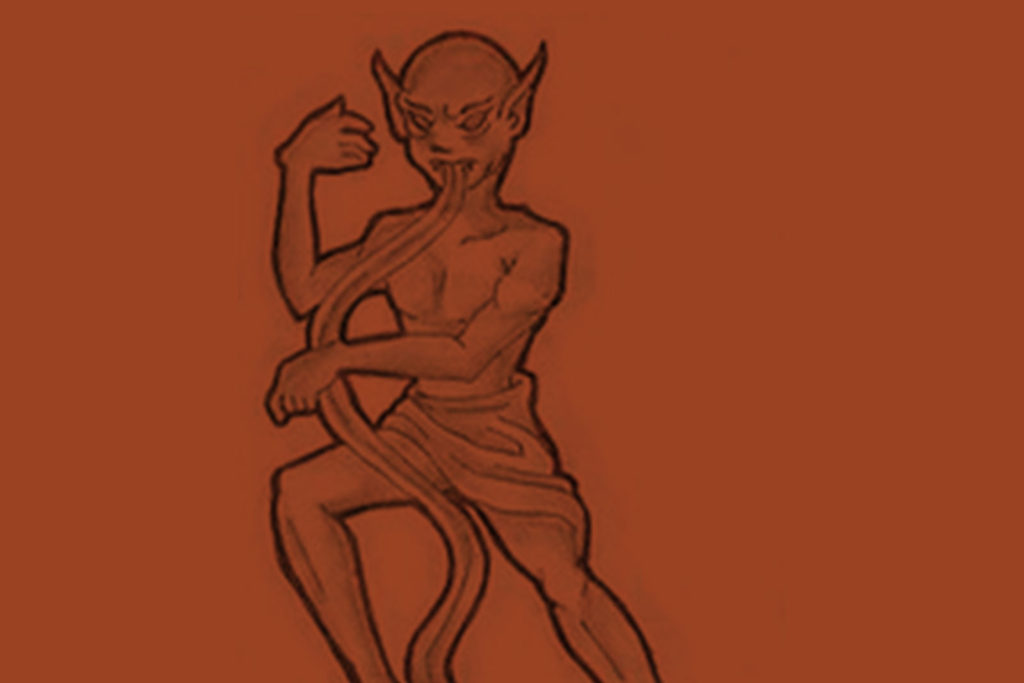
I still remember the first time I heard of the tiktik. It was 2008, and I was huddled with the other kids in my neighborhood, in front of a dark, abandoned house flanked by two street lamps. We were a group of scruffy children with skinned knees and worn-out tsinelas, expecting the call of ourparents to come echoing from a few homes down the road.
But it didn’t matter how much time we had left. When we gathered for scary stories, Tomas managed to stretch a few minutes into hours.
“It was my tita in the province,” he started, leaning in. “They lived in a little kubo, so they always slept on the floor. They didn’t have any electricity, either – just a lamp and a candle they used every other night.

When she became pregnant, a tiktik hunted her for weeks. The loud sound started appearing for days at a time – tik-tik-tik-tik! She was so scared she started sleeping with garlic cloves and a circle of salt around her. She thought it worked. The tiktik’s call started getting fainter and fainter. She put away the cloves and the salt. She slept better.
Until one night, when her house started shaking.”
He paused and wiped away something on his cheek with the sleeve of his ratty shirt. He looked up at the skies. “It was a full moon. The moonlight and candle helped her see as she awoke. There was a long, sharp tongue reaching for her stomach by the window. She rolled away from the window and screamed for her husband to wake up. The tiktik moved to their roof, the tongue stretching down to the floor.”
“How did they escape?” someone in our group interrupted. Tomas cut a look at them, annoyed. But it was short-lived – his expression became thoughtful.
“I actually don’t know.”
“It was a full moon. The moonlight and candle helped her see as she awoke. There was a long, sharp tongue reaching for her stomach by the window. She rolled away from the window and screamed for her husband to wake up. The tiktik moved to their roof, the tongue stretching down to the floor.”
Murmurs broke out between all of us.
“All I know is that they were on the neighbor’s truck the next day. She climbed in with their possessions in the back. They didn’t feel safe anymore – not with my tita expecting a child so soon. They had heard the tiktik that morning, but it seemed to have just… gone.
My tita was enjoying the drive and looking ahead. Then, she heard this weird flapping noise from below the car. She peeked over, and…”
His voice had dropped to a whisper. We all leaned in.
“BOO!”
He threw his head back and laughed as we stepped away from him, muttering complaints.
It’s been years, but that childhood story remains embedded in my mind. It taught me everything I needed to know from such an elusive creature.
Unlike other creatures of Philippine folklore, the tiktik rarely has its own spotlight. It was the footnote, the extra detail, taking up just a line or two in the story. I haven’t encountered any sort of history dedicated to the tiktik alone.
But this is what I do know: you want to be able to hear it. Assuming you’re safe when its call is faint was always a fatal mistake. The nearer it gets, the quieter its call is – until its tongue can successfully entrap you to your death.
The tiktik that I knew of was another viscera sucker. But the few studies mentioning the tiktik say otherwise. In Ramos’ Belief in Ghouls in Contemporary Philippine Society, a tiktik is the viscera sucker’s guide, hunting for probable victims. In Reyes’ book of Filipino Medical Mythology, he identifies the tiktik as a little bird.
The aswang, in this case, takes many forms: commonly, it was a fair, attractive woman or a wild animal. When it’s the former, the aswang was likely a manananggal, flying with the bird beside her.
So, how come all the stories I’ve heard of the tiktik don’t identify it as an aswang’s familiar, but a whole other creature?

I could blame the nature of folklore. The tiktik is often mentioned alongside the wakwak, another viscera sucker with bird-like features. While I’ve heard stories separating the tiktik, wakwak, and manananggal as distinct from another, Vicerra and Javier name the wakwak and manananggal as one and the same. The latter is the Tagalog term, while the former a Visayan one. Another study by Fe Susan Go identifies the wakwak as just the call of the aswang. It isn’t false – both the words tiktik and wakwak are the creatures’ calls – but it doesn’t mention the wakwak being a creature on its own.
I hear a sound eerily close to a tiktik as I write this. It’s the same one since my childhood. I would run to the adults during the instances that I think I heard the tiktik. They always dismissed my fears.
“You just hear the insects. They come out at night.”
I was never entirely convinced.
Tiktik, wakwak, manananggal – what are names? Identifying what creature it is hardly matters when it corners you in your own home.
References:
Belief in Ghouls in Contemporary Philippine Society, Maximo Ramos (1968)
Sex, Masturbation and Foetal Death: Filipino Physicians and Medical Mythology in the Late Nineteenth Century. Social History of Medicine, R.A.G Reyes (2008)
Tabi-Tabi Po: Situating The Narrative of Supernatural in the Context of the Philippines Community Development, Paulo Miguel Vicerra and Jem R. Javier (2013)
Mothers, Maids, and The Creatures of the Night: The Persistence of Philippine Folk Religion, Fe Susan Go (1979)
























